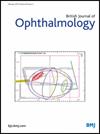球当量预测中国儿童青少年近视发生和发展的参考值
IF 3.5
2区 医学
Q1 OPHTHALMOLOGY
引用次数: 0
摘要
背景/目的建立预测中国儿童和青少年近视发生和发展的性别和年级特异性的单眼麻痹球当量(SE)参考值。方法于2020年至2024年对67 260名中国幼儿园至高中学生进行视力筛查。近视定义为单眼偏瘫SE≤- 0.50屈光度(D),高度近视≤- 6.00D。使用lambda-mu-sigma方法估计每个级别的- 0.50D和- 6.00D的睫状体麻痹SE的百分位数。在此基础上,确定了预测未来近视及其向高度近视发展的参考值。结果12年级男生(高三)近视和高度近视的估计患病率分别为82.4%和11.6%。0-11年级男生的眼瘫SE值分别为82.4和11.6百分位,可作为预测12年级近视和高度近视的参考值。例如,在幼儿园高年级男生(0年级)中,患有单纯性脑瘫的SE >1.54D(82.4百分位)的学生在12年级前不会出现高度近视,而患有SE >0.19D(11.6百分位)的学生在12年级前不会出现高度近视。结论建立了预测中国学生近视和高度近视的参考值,但这些参考值可能不适用于中国以外的人群。然而,所提出的方法可以应用于学生近视流行模式保持相对稳定的环境。如有合理要求,可提供资料。研究人员应提交一份研究计划,概述研究目标和任何拟议的分析,并通过以下电子邮件:guoxin@chinacdc.cn或liujm@pku.edu.cn索取未识别的参与者数据。本文章由计算机程序翻译,如有差异,请以英文原文为准。
Reference values of spherical equivalent for predicting the onset and progression of myopia among children and adolescents in China
Background/aims To establish sex-specific and grade-specific reference values of cycloplegic spherical equivalent (SE) for predicting myopia onset and progression in Chinese children and adolescents. Methods Between 2020 and 2024, vision screening was conducted among 67 260 Chinese students spanning kindergarten to high school. Myopia was defined as a cycloplegic SE of ≤−0.50 diopters (D) and high myopia as ≤−6.00D. The lambda-mu-sigma method was used to estimate centiles of cycloplegic SE for −0.50D and −6.00D at each grade. Based on this, reference values for predicting future myopia and its progression to high myopia were determined for all grades. Results Among boys in grade 12 (the third year of high school), the estimated prevalence of myopia and high myopia was 82.4% and 11.6%, respectively. For boys in grades 0–11, the cycloplegic SE values at the 82.4th and 11.6th percentiles served as reference values to predict myopia and high myopia, respectively, in grade 12. For example, among senior kindergarten boys (grade 0), those with cycloplegic SE >1.54D (82.4th percentile) were predicted to remain non-myopic before grade 12, whereas those with SE >0.19D (11.6th percentile) were not expected to develop high myopia before grade 12. Conclusions Reference values for predicting myopia and high myopia among Chinese students were established, but these values may not be applicable to populations beyond China. Nevertheless, the proposed methods could be applied to settings where student myopia prevalence patterns remain relatively stable. Data are available upon reasonable request. Researchers should submit a research plan outlining the objective and any proposed analyses, and request the de-identified participant data via the following email: guoxin@chinacdc.cn or liujm@pku.edu.cn.
求助全文
通过发布文献求助,成功后即可免费获取论文全文。
去求助
来源期刊
CiteScore
10.30
自引率
2.40%
发文量
213
审稿时长
3-6 weeks
期刊介绍:
The British Journal of Ophthalmology (BJO) is an international peer-reviewed journal for ophthalmologists and visual science specialists. BJO publishes clinical investigations, clinical observations, and clinically relevant laboratory investigations related to ophthalmology. It also provides major reviews and also publishes manuscripts covering regional issues in a global context.

 求助内容:
求助内容: 应助结果提醒方式:
应助结果提醒方式:


